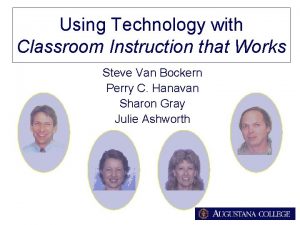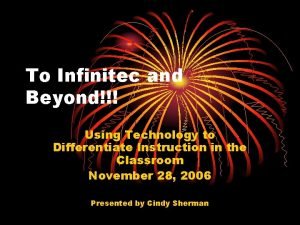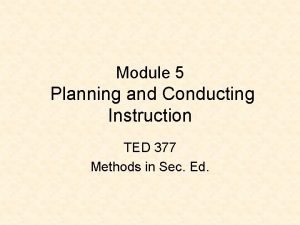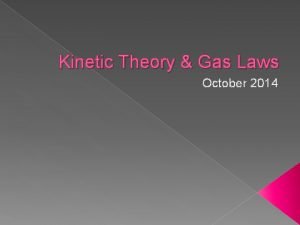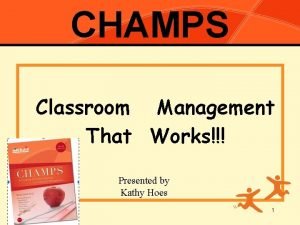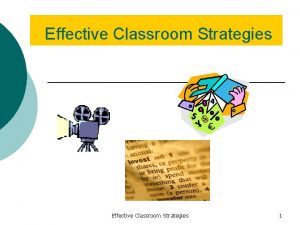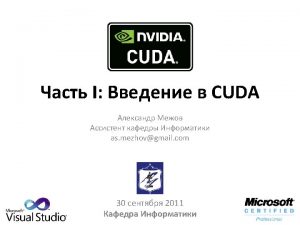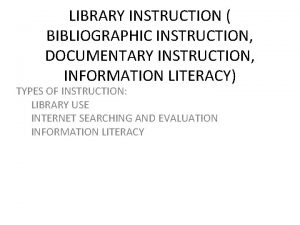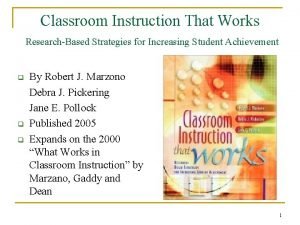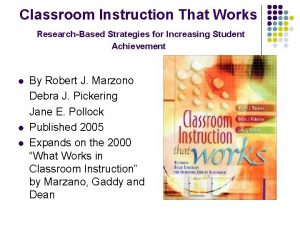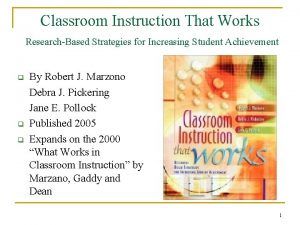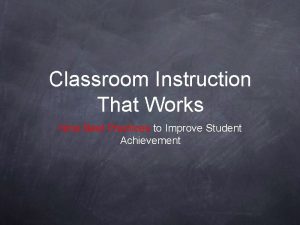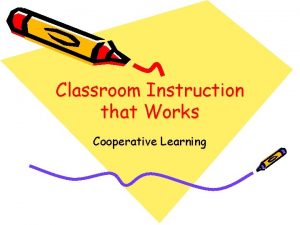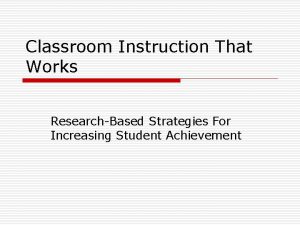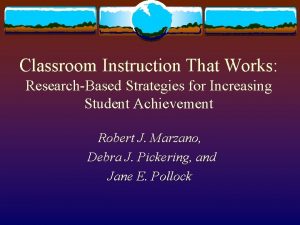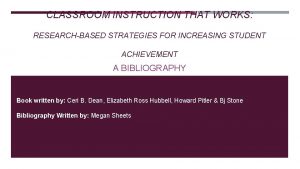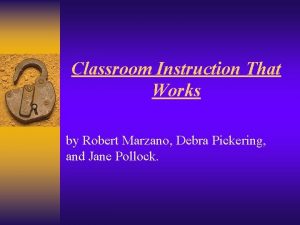Using Technology with Classroom Instruction that Works Steve























- Slides: 23

Using Technology with Classroom Instruction that Works Steve Van Bockern Perry C. Hanavan Sharon Gray Julie Ashworth

Au. D. /Ed. D

Millennial

Web Access Trends 98% of schools are wired for Internet access

Moms Online More Than Teens • Net-surfing moms spend an average 16 hours, 52 minutes a week on the Internet, • Teens average 12 hours, 17 minutes online each week, – DMS gathered data from more than 8, 000 mothers who use the Net through AOL and other Internet service providers (ISPs). Dick Kelsey, Newsbytes, DULLES, VIRGINIA, U. S. A. , 07 May 2002, 10: 47 AM CST, Washington Pos AOL subsidiary Digital Marketing Services (DMS) Survey

Old vs. New Technology It’s not how hard you work… It’s how much work you get done

Classroom Instruction That Works by Marzano, Pickering and Pollock • Research-Based Strategies for Increasing Student Achievement

Nine Instructional Strategies 1. 2. 3. 4. 5. 6. 7. 8. 9. Identifying similarities and differences Summarizing and note taking Reinforcing effort and providing recognition Homework and practice Nonlinguistic representations Cooperative learning Setting objectives and providing feedback Generating and testing hypothesis Questions, cues, and advance organizers

Identifying Similarities and Differences þ Compare þ Classify þ Create metaphors þ Create analogies

Summarizing and Note Taking þ “Rule-Based” strategy þ Reciprocal teaching þ Teacher-Prepared þ Informal outlining þ Webbing þ Combination

Reinforcing Effort and Providing Recognition þ Teach about effort þ Keep track of effort and achievement þ Personalize recognition þ Pause, prompt, and praise þ Concrete symbols of recognition

Homework þ Establish and communicate a homework policy þ Design homework assignments that clearly articulate the purpose and outcome þ Vary the approaches to providing feedback þ Chart accuracy and speed þ Design practice that focuses on specific elements of a complex skill or process þ Plan time for students to increase their conceptual understanding of skills or processes

Nonlinguistic Representations þ Create graphic organizers þ Make physical models þ Generate mental pictures þ Draw pictures and pictographs þ Engage in kinesthetic activity

Cooperative Learning þ Use a variety of criteria for grouping students þ Combine cooperative learning with other classroom structures

Setting Objectives and Providing Feedback þ Set specific but flexible goals þ Develop contracts þ Provide Rubrics þ Focus feedback for specific types of knowledge and skill þ Utilize student-led feedback

Generating and Testing Hypotheses þ Structure tasks to guide students through generating and testing hypotheses þ Ensure that students can explain their hypotheses and their conclusions

Cues, Questions, Advance Organizers þ Provide explicit cues þ Develop questions that elicit inferences þ Generate analytic questions þ Provide expository advance organizers þ Present narrative advance organizers þ Utilize skimming as a form of advance organizers þ Develop graphic advance organizers

Identifying Similarities & Differences

Similarities and Differences • Brian Maxwell, world class marathon runner and inventor of the Power. Bar, promoted as scientifically formulated to provide energy to athletes and support optimal health. In 1971, he accepted a track scholarship to UC Berkeley. By the time he graduated in 1975 with a degree in architecture, he had been honored with the Brutus Hamilton Award for his achievements on the school's track team. In 1977, Maxwell was ranked as the No. 3 marathon runner in the world. Maxwell died young, at the age of 51, after suffering an apparent heart attack. • Hanna Barysevich of Minsk, Belarus, a woman believed to be the oldest in the world celebrated her 116 th birthday this week in the former Soviet republic of Belarus. "I'm tired of living already, but God still hasn't collected me, " she said with a smile. Barysevich was born on May 5, 1888, in the village of Buda, 37 miles east of Minsk. Her parents were poor, landless peasants. "From my early childhood I didn't know anything but physical labor, " said Barysevich, who never learned to read or write. She worked in a kolkhoz, or collective farm, until age 95, then moved to the house shares with her 78 -year-old daughter Nina. "I'll drink to my own health with pleasure, " said Hanna, a former farm worker who lives in a house outside Minsk. Hanna prefers simple village food: homemade sausages, pork fat, milk and bread.

Identifying Similarities & Differences • Brian Maxwell, world class marathon runner and inventor of the Power. Bar, promoted as scientifically formulated to provide energy to athletes and support optimal health. In 1971, he accepted a track Power. Bar is to _____ scholarship to UC Berkeley. By the time he graduated in 1975 with a degree in architecture, he had been honored with the Brutus Hamilton Award for his achievements on the school's track team. In 1977, Maxwell was ranked as the No. 3 marathon runner in the world. Maxwell died young, at the age of 51, after suffering an apparent heart attack. • Hanna Barysevich of Minsk, Belarus, a woman believed to be the oldest in the world celebrated her 116 th birthday this week in the former Soviet republic of Belarus. "I'm tired of living already, but God still hasn't collected me, " she said with a smile. Barysevich was born on May 5, Pork fat is to _____ 1888, in the village of Buda, 37 miles east of Minsk. Her parents were poor, landless peasants. "From my early childhood I didn't know anything but physical labor, " said Barysevich, who never learned to read or write. She worked in a kolkhoz, or collective farm, until age 95, then moved to the house shares with her 78 -year-old daughter Nina. "I'll drink to my own health with pleasure, " said Hanna, a former farm worker who lives in a house outside Minsk. Hanna prefers simple village food: homemade sausages, pork fat, milk and bread.

Identifying Similarities & Differences • • Brian Maxwell, world class marathon runner and inventor of the Power. Bar, promoted as scientifically formulated to provide energy to athletes and support optimal health. In 1971, he accepted a track scholarship to UC Berkeley. By the time he graduated in 1975 with a degree in architecture, he had been honored with the Brutus Hamilton Award for his achievements on the school's track team. In 1977, Maxwell was ranked as the No. 3 marathon runner in the world. Maxwell died young, at the age of 51, after suffering an apparent heart attack. Hanna Barysevich of Minsk, Belarus, a woman believed to be the oldest in the world celebrated her 116 th birthday this week in the former Soviet republic of Belarus. "I'm tired of living already, but God still hasn't collected me, " she said with a smile. Barysevich was born on May 5, 1888, in the village of Buda, 37 miles east of Minsk. Her parents were poor, landless peasants. "From my early childhood I didn't know anything but physical labor, " said Barysevich, who never learned to read or write. She worked in a kolkhoz, or collective farm, until age 95, then moved to the house shares with her 78 -year-old daughter Nina. "I'll drink to my own health with pleasure, " said Hanna, a former farm worker who lives in a house outside Minsk. Hanna prefers simple village food: homemade sausages, pork fat, milk and bread.

Online PPT • • Nine Instructional Strategies Classroom Applications Using Excel Transforming Teaching Through Tech Classroom Instruction

In Conclusion: Our task is to provide an education for the kind of kids we have. Not the kind of kids we used to have, or want to have, or the kind that exists in our dreams.
 Using technology with classroom instruction that works
Using technology with classroom instruction that works Using technology with classroom instruction that works
Using technology with classroom instruction that works Infinitec online classroom
Infinitec online classroom Ngoại tâm thu thất chùm đôi
Ngoại tâm thu thất chùm đôi Block xoang nhĩ độ 2
Block xoang nhĩ độ 2 Thể thơ truyền thống
Thể thơ truyền thống Thơ thất ngôn tứ tuyệt đường luật
Thơ thất ngôn tứ tuyệt đường luật Walmart thất bại ở nhật
Walmart thất bại ở nhật Tìm vết của mặt phẳng
Tìm vết của mặt phẳng Con hãy đưa tay khi thấy người vấp ngã
Con hãy đưa tay khi thấy người vấp ngã Tôn thất thuyết là ai
Tôn thất thuyết là ai Gây tê cơ vuông thắt lưng
Gây tê cơ vuông thắt lưng Sau thất bại ở hồ điển triệt
Sau thất bại ở hồ điển triệt Steve jobs, steve wozniak and ronald wayne
Steve jobs, steve wozniak and ronald wayne Street works book
Street works book Individualized instruction vs differentiated instruction
Individualized instruction vs differentiated instruction Site:slidetodoc.com
Site:slidetodoc.com Planning and conducting instruction in the classroom
Planning and conducting instruction in the classroom Smart classroom vs traditional classroom
Smart classroom vs traditional classroom Explain using the gas law how hot air balloon works
Explain using the gas law how hot air balloon works Middle level integration
Middle level integration Technology for the esl classroom
Technology for the esl classroom Using assessment to drive instruction
Using assessment to drive instruction Champs attention signal
Champs attention signal
